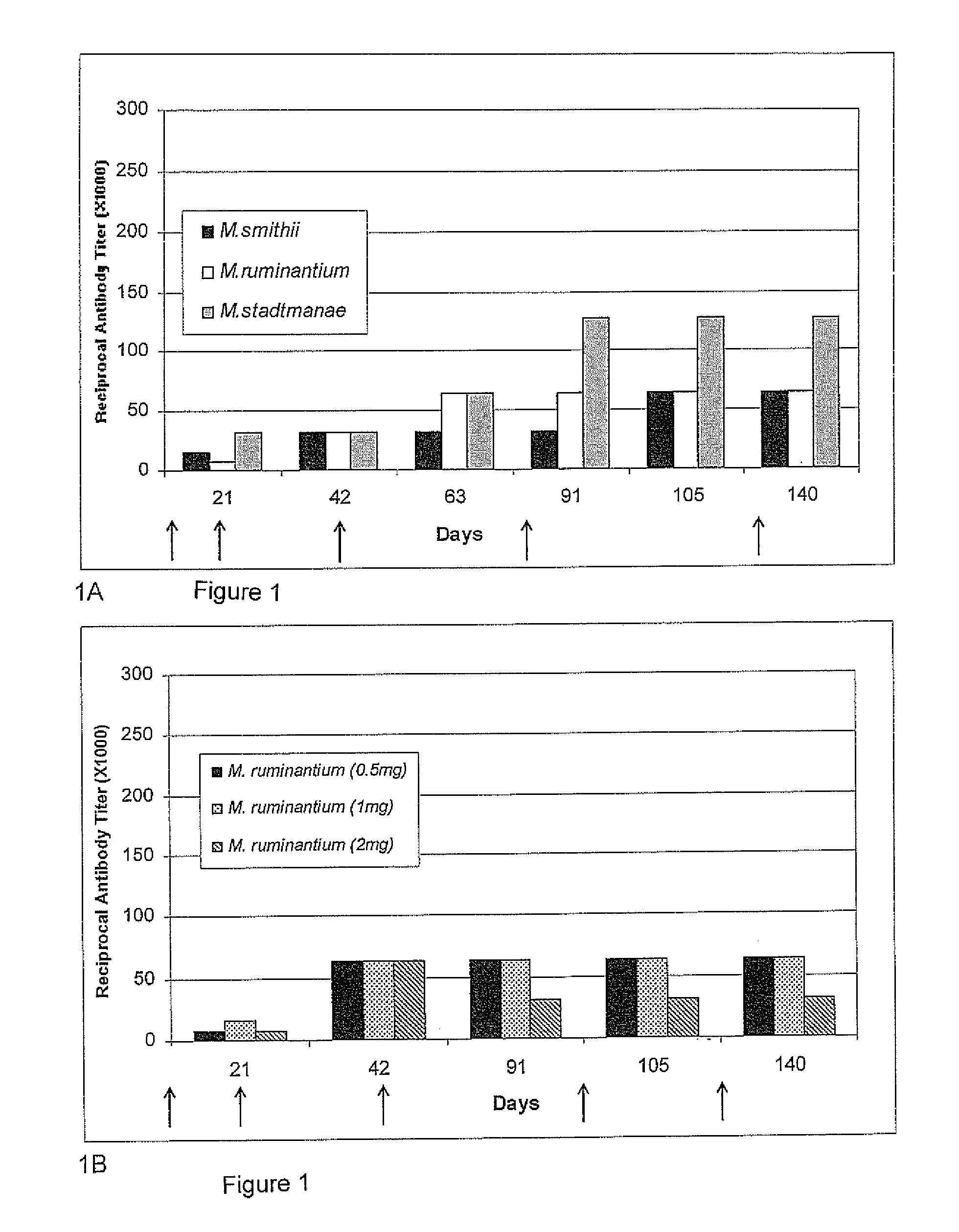Use of avian anti-methanogen antibodies for reduction of methane production
a technology of methane and anti-methanogens, which is applied in the field of use of avian anti-methanogen antibodies for the reduction of methane production, can solve the problems of no report to date on the generation of avian anti-methanogens and their effect on methane reduction, and achieve the effects of reducing methane gas production
- Summary
- Abstract
- Description
- Claims
- Application Information
AI Technical Summary
Benefits of technology
Problems solved by technology
Method used
Image
Examples
experiment 1
[0039]None of the purified antibody treatments decreased CH4 production over the duration of the experimental period compared with the non-immune control (Table 1). Cumulative CH4 produced was similar at each sampling point, with 27.03±0.205 mg g−1 DM CH4 produced after 24 h incubation. A slight depression of total gas produced was noted in the α-RUM treatment after 2 h and in the α-STAD treatment after 2 and 12 h. However, total gas produced recovered to become similar (P=0.86) among all treatments by the end of the incubation period (Table 1). Net ammonia and pH measures were also similar throughout the experimental duration (P>0.05). Likewise, IVDMD was not affected by specific antibody treatments (P=0.91).
[0040]Total VFA concentrations were similar between control and treatment groups (P=0.63). Equal proportion of acetate, propionate, butyrate and minor VFA were detected in control and treatment groups (Table 1), suggesting that the VFA profile was unaltered by treatment with sp...
experiment 2
[0044]As ruminant fluid was used as source of methanogens in in vitro fermentation process in Experiment 2, to assess the effect of anti-methanogen antibodies on methane production, it was considered to be important to determine if anti-methanogen antibodies recognize methanogens present in the ruminant fluid. To confirm that the ruminant fluid contains methanogens, the reactivity of ruminant fluid was tested by ELISA against the three anti-methanogen antibodies. It was demonstrated from the results that all three anti-methanogen antibodies showed strong reactivity against the ruminant fluid, a reactivity similar to the homologous antigen. Again, the strongest reactivity was obtained with the anti-M. stadtmaniae antibodies, followed by anti-M. smithii and anti-M. ruminantium antibodies (Table 4). Thus, it was confirmed that ruminant fluid contains at least the target methanogens.
[0045]The effects of avian antibody on in vitro fermentation are summarized in Table 5. Three of the trea...
experiment-2
[0058]The same in vitro ruminal incubation techniques described for Trial 1 were used with the following modifications. On the day prior to incubation 0.6 g of antibody (12 mg of IgY) in freeze-dried egg powder from hens immunized with one of the three antigenic preparations with MONTANIDE ISA 70 (α-RUMI, α-SMIT, α-STAD), or a mixture of all three antibodies (Combo) was weighed into triplicate vials per treatment for each of the sampling times and stored overnight at 4° C. Equal quantities (0.2 g) of each egg powder preparation were represented in the antibody combo treatment. At the same time, freeze-dried alfalfa (28.1% CP and 41.6% NDF) ground to 1-mm was weighed into the serum vials. Ruminal fluid inoculum was collected from three dairy cows fed a TMR diet (16.7% CP, 34.4% NDF) consisting of 46% of a concentrate (20.5% canola, 20.4% soybean meal, 17% corn gluten meal, 14% barley ground, 12% beet pulp, 6.4% dried molasses, and 9.7% minerals), 41.5% whole crop barley silage, 7.5% ...
PUM
| Property | Measurement | Unit |
|---|---|---|
| antibody titer | aaaaa | aaaaa |
| global warming potential | aaaaa | aaaaa |
| dietary energy | aaaaa | aaaaa |
Abstract
Description
Claims
Application Information
 Login to View More
Login to View More - R&D
- Intellectual Property
- Life Sciences
- Materials
- Tech Scout
- Unparalleled Data Quality
- Higher Quality Content
- 60% Fewer Hallucinations
Browse by: Latest US Patents, China's latest patents, Technical Efficacy Thesaurus, Application Domain, Technology Topic, Popular Technical Reports.
© 2025 PatSnap. All rights reserved.Legal|Privacy policy|Modern Slavery Act Transparency Statement|Sitemap|About US| Contact US: help@patsnap.com



